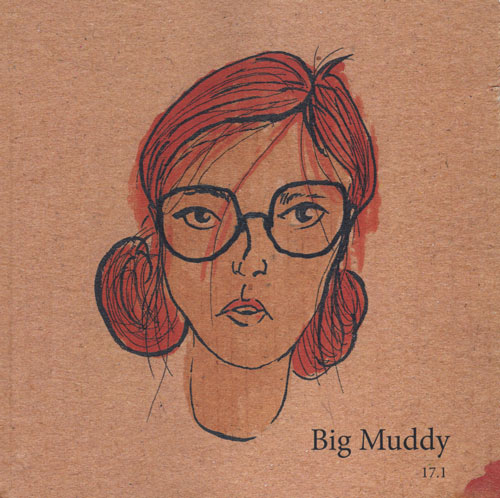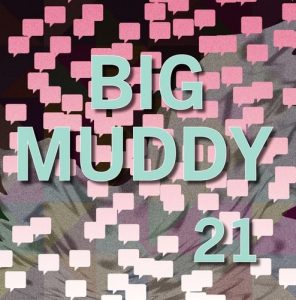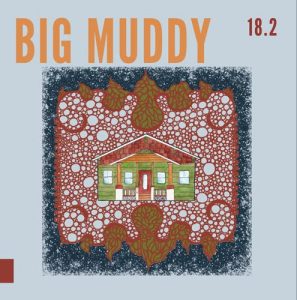Big Muddy – 2017

Published out of Southeast Missouri State University Press, Big Muddy showcases works and authors “related to the Mississippi River basin and its bordering ten-state area.” While that might at first seem limited, there is no sense of that limitation in reading this publication. On the contrary, the genre styles, subject matter, and author backgrounds are so broad, “big” is even an understatement. More like its river’s namesake, this Big Muddy meanders, rages, roils, and gently laps through the gamut of literary creative expression.
Of the poetry, Cindy King was one of the standouts. She melds concrete imagery with the fantastic, playfully enticing the reader as in this opening of “Summer’s End”:
Night walks on its hands,
Comes juggling bowling balls
And chainsaws. Night arrives
Hissing in a skillet,
Smelling of beer and catfish,
Has yet to meet the box fan
Since its argument with the wind.
Yet there is a strange longing—for the feelings of the past or for what never was—in her works, as there are in several other poems in this collection. Jeanne Emmons’s works focus on the singular subject of the red canoe, and in “The Photograph of the Red Canoe” she writes, “There is the scene, just as it was, / the canoe afloat on a sky of reflected clouds, / but missing movement, the faint undulance.” In the follow-up poem, “The Red Canoe Wishes Not to Be Red,” the personification of the canoe is presented in such a way that it is deeply emotional, not at all trivialized as can sometimes happen with such attempts:
The red canoe shrinks down beside
the dock, wants not to rock not to be
red. If she counted, she would learn that
the flock number two-hundred and nine,
but she does not count. She cringes,
too conscious of her color to worry
about numbers. She is trying
to hide her hull, to ride low in the lake
that upholds and exposes her.
Charlotte Covey’s poems are styled in such a way that they bring the reader in, and much like a hurricane or tornado, seemingly pull up imagery and emotion in a tumultuous path before releasing the reader back to a landing point at the end. “hay fever” takes the speaker into a past:
[. . .] where we used
to carry our weight to the lapping
water, the stillness of the rocks beneath
our calloused, unwashed feet, I still see
you running past treeslike you believed in something
more than dewy grass and hangingswings, [. . . ]
While “older” begins with “once, a jellyfish stung me / in the eye.” But then shifts from “how red my eye got” to
[. . . ] once,
i got so high my eyes turned blood–
shot, and I kept falling
asleep as he pushed his way
inside [. . . ]
And at the close takes readers back to the jellyfish sting, imagining a time when that was the greatest worry of the day.
“Franklin County Prometheus” by Zachary Lundgren reveals the unique perspective of a boy’s summer memory, beginning, “Boys around the fire, passing a bottle / to burn these lips, inspire unripe lungs.” The bonfire speaks its gratitude, and Lundgren writes:
We don’t know how to reply, so
I offer another log – abovethe sky smiles
mouth empty of thunder.
Leah Angstman offers geographical poems, even though “Echolocating” isn’t about any place in particular, as “Nebraska” and “Minnesota’s skeletons” are. This poem examines the metaphor of deaf bats, which, she writes, “We don’t talk about them now— / Not for any reason but that folks don’t mention / what isn’t here, what disappears to disease and history.”
Of the fiction included in this issue, Mighty River Short Story Contest Winner “In the Jungle” by Jeremy Griffin certainly got my vote of approval. Following the downfall of Collier, a CFO for a large food corporation, the plot of poor business decision cover-ups reads like non-fiction from a newsweekly article. Griffin weaves in the CFO’s memories of watching children’s television programing with his grandsons with his failed business merger and, then shockingly, with a shooter entering his office building—this all revealed within the first four paragraphs of the story. Griffin then puts the shooter and the reader on hold while the narration goes back through the pressure and poor decisions Collier has made, his desperate lies and false record keeping eliciting an empathy from the reader that doesn’t result in pity, but rather a better understanding of the closing stand-off:
But as the barrel settled only inches from his nose, Collier recognized something in the man’s demeanor: a dark and quavering desperation, as if he had been compelled here against his will.
[. . . ]
And yet Collier wasn’t afraid.
Nor was he unafraid for that matter. Staring down the barrel of the revolver, he found to his astonishment that he couldn’t feel anything. The moment was too immense, too real, to justify any emotional response.
His response is one for the ages, and I can only guess leaves the shooter in the story as astonished as the reader.
Jeffrey Condran’s fiction “1983” was among those works that literally stole my heart. The narrator, twelve-year-old Nick, runs into the wall of older brother Martin’s expectations of him to be a real man, which apparently means liking guns, girls, baseball, and beating up on sandbags as practice for human targets. Enter Jeffrey Matsuyama, a cap wearing Batman lover, whose ass Martin commands Nick to go kick:
“It’s time you started making a mark in the world. No more little boy bullshit. No more coddling. That kid,” Martin said pointing again at the boy in the red cape, “has clearly been coddled. You’d be doing him a favor by showing him there are real enemies in this world.”
To my relief, not really wanting to see this cool superhero kid get pounced, Nick won’t do it. Instead, they engage in a conversation with Jeffrey, and learn that he can tell “non-believers” with some small clicker device he calls “The Bat-Sonar”:
“That’s awesome,” I said before I could stop myself.
“You’re a fuck-wit, you know that?” Martin said, like he was mortally offended. I half expected that he would punch his fist through the fence and rip the boy onto our side. “How old are you? Don’t answer, I don’t think I can bear to hear.”
Jeffrey Matsuyama’s faced turned bright red and his eyes welled up with tears. He pointed his Bat Sonar at Martin and clicked it twice: click-click, click-click. “You’re not a believer,” he said.
“Get the fuck away from me,” Martin replied.
Nick meets up with Jeffery later and the two strike up a comradery that is a refreshing storyline to the bullying and beating up we know so many of these weirdos (like us) suffer through in childhood. The portrayal of the friendship between these boys is endearing, and their ultimate separation as the result of dumb adults, heartbreaking. Condran’s skill is the ability to develop characters that can so intimately influence reader imagination and emotion. Sad ending? Can’t say, since with so many of these childhood tales, how the adults turn out is the true success or tragedy of their own growing up.
There are also several essays included, rounding out a compendium of genres for readers to choose from. Jera Brown’s “The apple house” was a favorite for me, speaking to the idea of home ownership, how we invest not just our money, but our whole selves into a place, a building, a simple structure. How a place can bring people together, even when they part; it is because of that place that the people still have a common bond—even years later. For anyone who can’t understand the value of home ownership, this essay reveals that it is much greater than any financial investment, and why so many people try to hold on to their ‘place’ even when facing great financial loss.
For those looking for a summer getaway, there’s still time to take a trip along the Mississippi River Basin, see this geographical region through a literary perspective of place and the people who take that place with them wherever they go. Big Muddy is ready to be your most accommodating tour guide.
[www.semopress.com/bigmuddy]
Big Muddy Volume 17 Number 1, 2017 reviewed by Denise Hill




